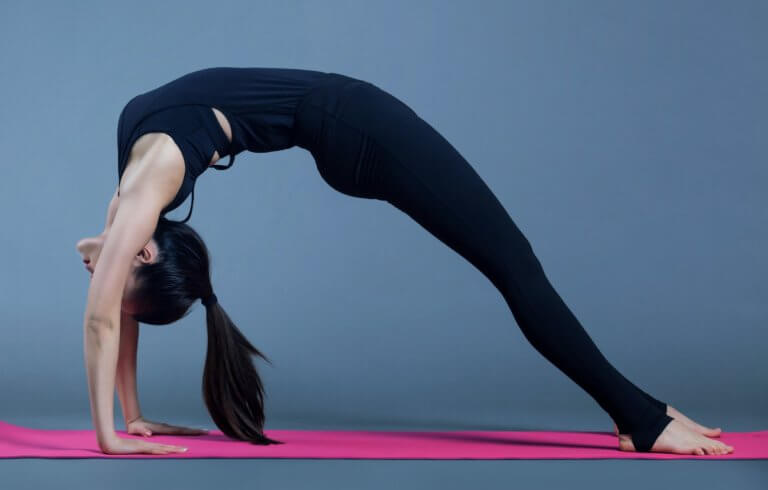Learning beginner gymnastics skills is about establishing a strong foundation for more advanced movements later on. Some blogs suggest that skills like the back walkover are beginner gymnastic skills, but we think that’s a little ambitious. In writing this blog, we referenced Gymnastics Canada’s development and evaluation program to outline 11 movements that are truly aimed at beginner gymnasts.
As gymnastics software developers we care deeply about the long-term development of gymnasts. These beginner gymnastics skills aren’t the flashiest but they are essential to safely learning more complex gymnastics movements later on.
Why is safety so important when learning beginner gymnastics skills?
Gymnastics is one of three foundational sports along with swimming and athletics.
This means that movements learned in gymnastics will be repeated across various other sports.
As a result, learning how to safely perform beginner gymnastics skills can be extremely beneficial for long-term athletic endeavors. Safe gymnastics training from a certified coach can help reduce injury, facilitate better movement and improve performance across the full spectrum of sport.
What safe learning looks like
In order to safely learn gymnastics, children must not only learn beginner gymnastics skills but also learn how to safely exit out of them. For example, let’s consider what goes into learning a handstand.
Many gymnastics spectators would guess that a handstand is a beginner gymnastics move, but coaches would disagree. There are numerous skills and iterations of skills that should be learned before a child attempts a handstand.
As a point of reference, Gymnastics Canada includes handstands in their Bronze badge level which is the fourth badge that a child earns as they progress through the CanGym development program. This means there are dozens of movements that must be mastered to earn Burgundy, Red and Tan badges, before a child should attempt a handstand.
As part of the leadup to safely learning a handstand, gymnasts may need to master leg-supported headstands, tripods, tucked headstands, open tucked headstands, and finally a headstand.
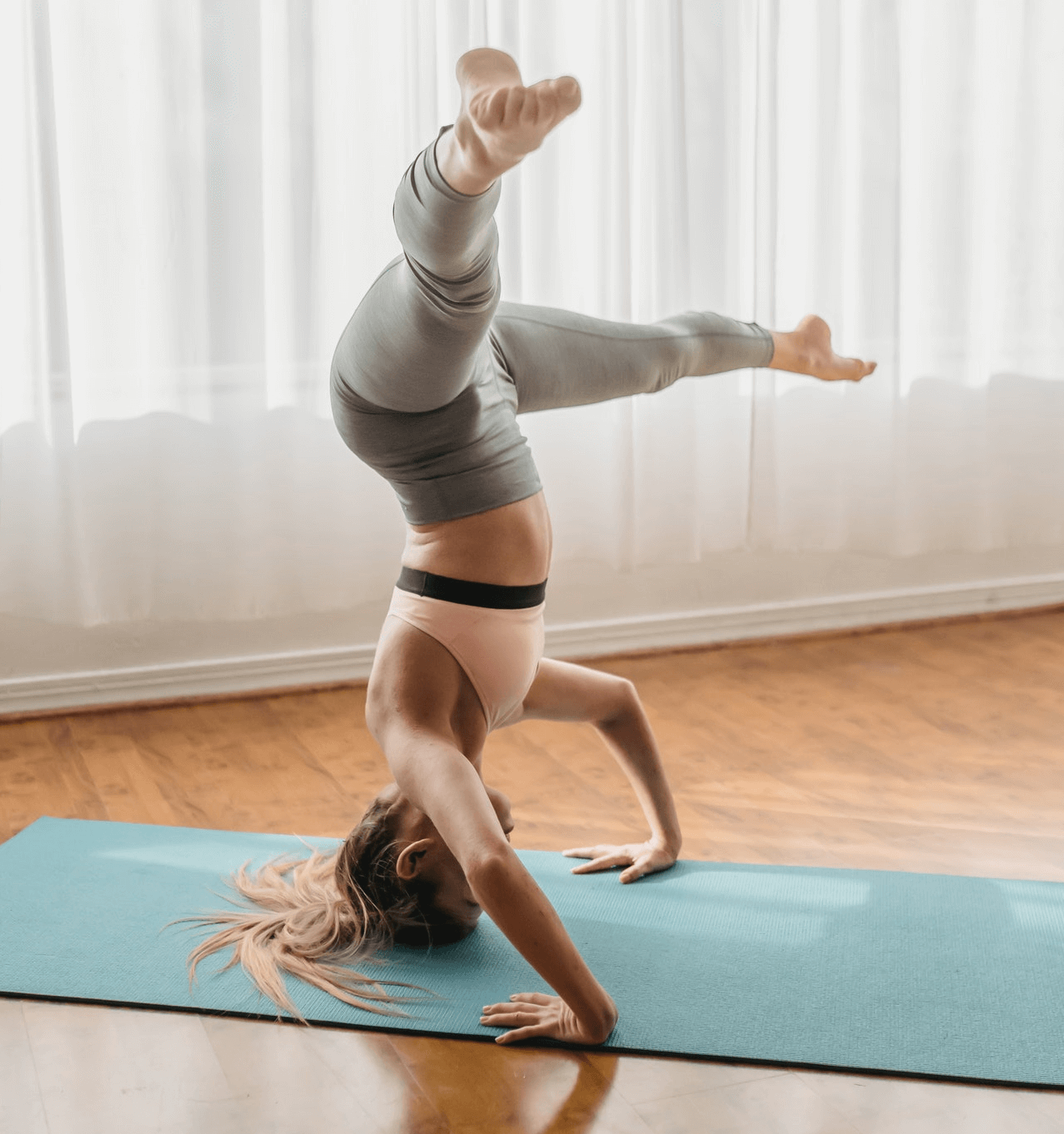
Each of these movements will allow children to experience and understand how to maintain their balance while inverted, using their core and supporting muscles.
Furthermore, gymnasts will learn how to safely exit out of these movements when they go off-balance. Part of that learning process may even include failing to safely exit out of a skill. But safe, progressive learning ensures that gymnasts have the opportunity to learn what it’s like to fall off-balance while learning easier skills so that they’re more prepared to tackle movements like the handstand.
In turn, all of this graduated learning under the guidance of certified coaches helps children gain the confidence and capabilities to safely attempt a skill like the handstand.
11 Beginner Gymnastics Skills
The following beginner gymnastics skills includes movements that appear throughout a gymnast’s development and across various apparatus.
1) Straddle Sit
The straddle sit familiarizes gymnasts with a position that will be practiced as a jump on floor, trampoline and beam. It’s also a movement that will appear as an isolated skill or in transition on vault, rings and bars. Because of its prevalence, learning a strong straddle sit can be very beneficial for young gymnasts.
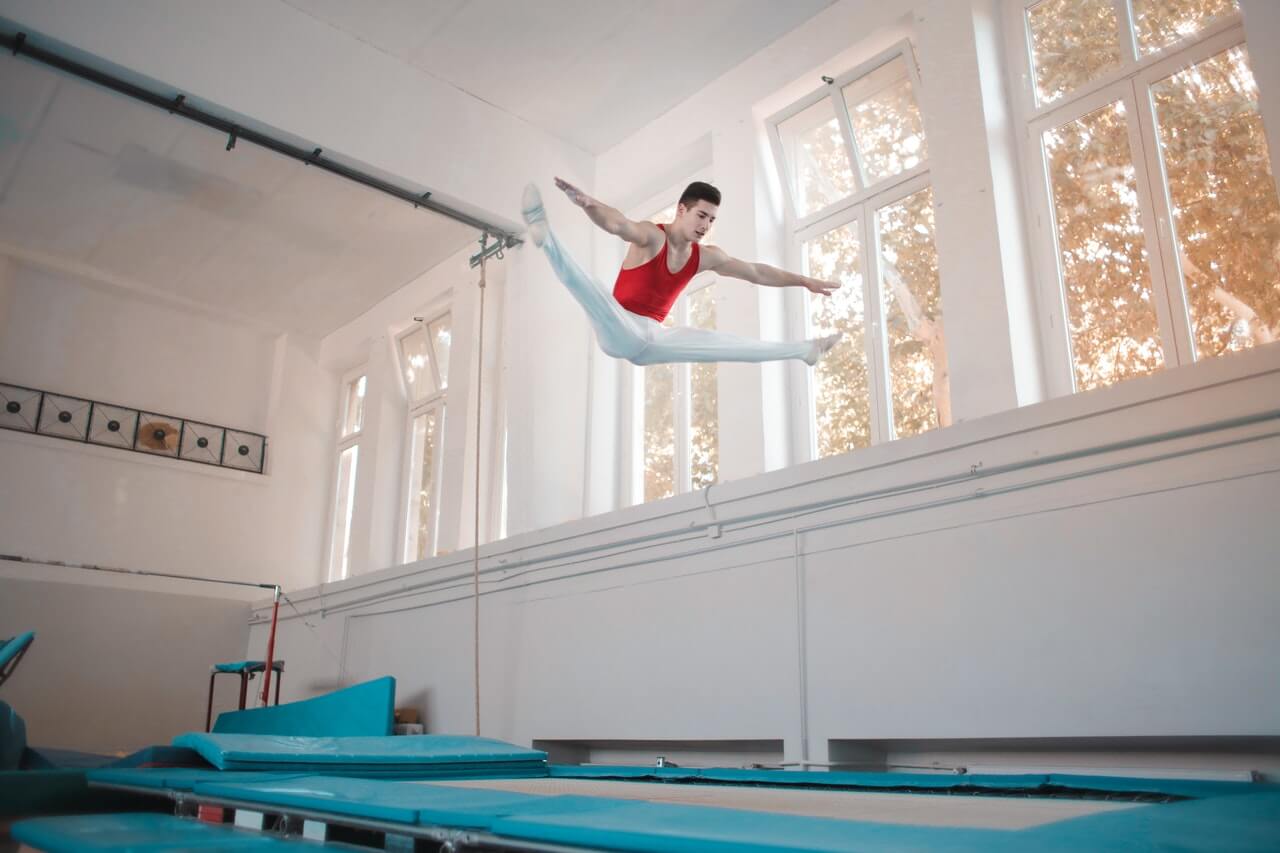
How to do a straddle sit: Gymnasts should sit up straight on the floor with their feet out in front of them. Placing their hands on the floor to help balance as they move, gymnasts should bring their legs apart until they’ve achieved a comfortable stretch. Legs should be flexed, with toes pointed.
When performing a straddle sit a gymnast’s knees should be facing up, not rolled inward. The chin should be up and arms can be raised over the head or extended and parallel to their legs like in the picture above.
2) Balance on one foot
Balance is key to gymnastics, that’s why one of the simplest beginner gymnastics moves is balancing on one foot.
This movement should first be practiced on floor before being moved to an elevated practice beam or regular balance beam.
How to balance on one foot: Standing up straight, gymnasts should lift one leg off the floor (or beam) and hold that position for at least 5 seconds. The gymnast’s leg can be bent, or straightened and held in front of them for increased difficulty. Arms can be held straight above the head or horizontal to help the gymnast balance.
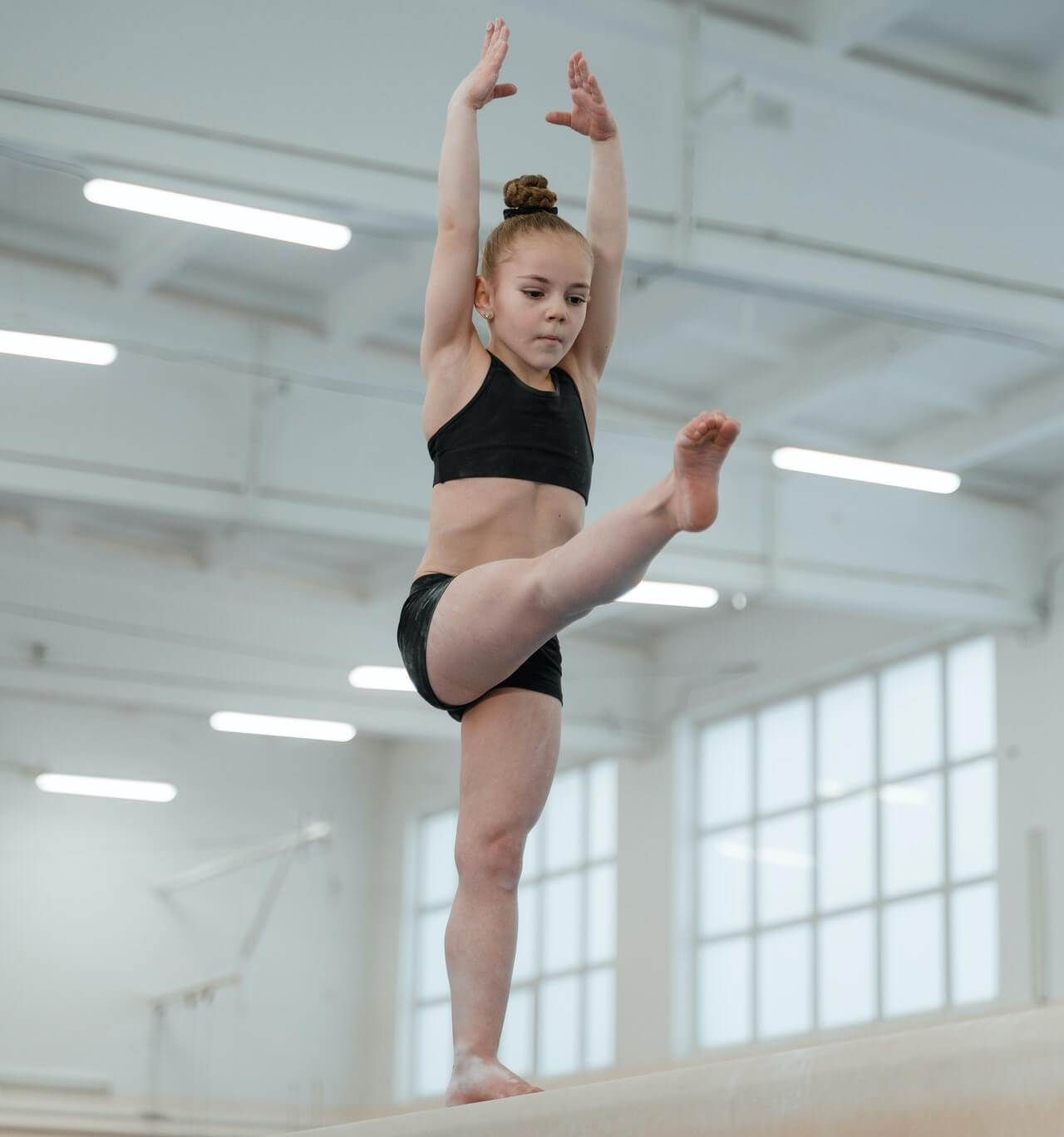
3) Hop to safe landing
Performing a hop to safe landing teaches the mechanics of a safe landing. This means the gymnast must learn how to land with their upper body balanced squarely over their feet (not leaning back or leaning forward). It also means the gymnast learns how to bend their knees to absorb impact. The height of the platform that gymnasts jump off should be appropriate for the beginner level.
How to hop to safe landing: From a raised platform, gymnasts should perform a two-foot jump to a two-foot landing, absorbing the impact of their landing with bent knees before extending back to a standing position.
4) Log roll
The log roll is a new movement that kids likely won’t encounter in their day-to-day activities. When performing a log roll, gymnasts must roll over without being able to spot the floor for part of their movement. This gives them experience in moving confidently toward a blind landing, a skill that will be repeated with movements like the front roll.
How to do a log roll: The gymnast should lie on their back with arms extended over their head and toes pointed. Slightly lifting their legs and arms off the mat, they should achieve a hollow body or concave shape and roll over onto their stomach. Gymnasts should then roll through to their back again. Some gymnasts may find it easiest to generate momentum by leading the roll with their hips.
The key is to complete this movement with a strong, flexed body, and ankles remaining pressed together.
5) Consecutive jumps
Practicing safe, two-foot landings is a great way to teach kids how to properly absorb the impact of landing. Consecutive jumps are the next step in this learning process. With consecutive jumps, gymnasts practice jumping with two feet, landing with two feet and then springing into a jump again, all in quick succession. This springing movement is key to joining advanced movements like round-offs and back handsprings later in a gymnast’s development.
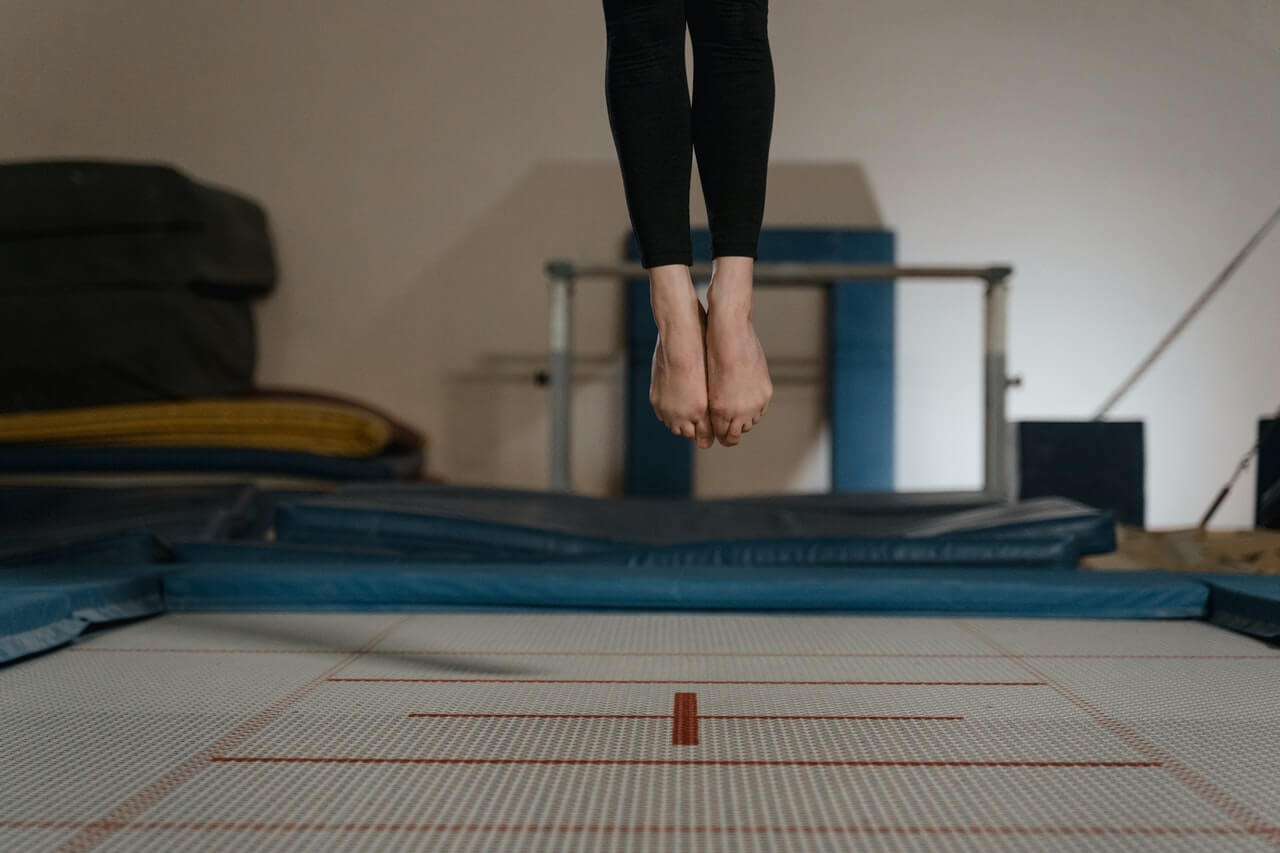
How to do consecutive jumps: Standing up straight on floor or trampoline, gymnasts bend their knees then spring up into the air. As soon as they land back on their feet they should spring up once again. Gymnasts should be able to produce 5-10 consecutive jumps with control, properly landing and springing back into their next jump in quick succession.
6) Forward roll
The forward roll teaches one of the most important safety movements in gymnastics: tucking your head.
By practicing a forward roll, gymnasts familiarize themselves with a movement they can repeat if they begin falling off-balance during headstands or handstands. They also learn how to control their bodies through inverted locomotion which is an essential skill repeated throughout advanced gymnastics.
How to do a forward roll: From the standing position, gymnasts should crouch down placing their hands on the mat shoulder-width apart. Next, they should tuck their head and lean forward on their toes, lifting the hips to begin rolling. Gymnasts should roll onto the shoulders and upper back, then through to the seated position. Feet should remain close to the gymnast’s seat so they may continue rolling forward from their seat onto their feet before rising to a standing position with arms extended over their hand.
7) Jump half turn
A jump half turn teaches gymnasts to develop the technique, trust and balance to land backward. This is a skill that will be relied upon at nearly every stage of a gymnast’s development.
How to do a jump half turn: Gymnasts should stand up straight with their arms extended above their heads. Bending at the knees, they should bring their arms down to their sides. Once the legs are loaded, spring up, lifting the arms back above the head to help generate power. As the athlete springs up, they should turn their shoulders and head in the direction they’d like to spin in order to initiate rotation. Gymnasts should stop the rotation of their shoulders and bring their chin back to center to complete their half turn, then land with bent knees, absorbing the impact and bringing their arms down to their sides before standing straight again with arms extended over their head.
8) Tuck Jump
The tuck jump requires that gymnasts generate enough power to form a tuck position in mid-air before extending their legs back down to a soft landing.
How to do a tuck jump: Gymnasts should stand up straight with their arms extended above their heads. Bending the knees, they should bring their arms down to their sides before springing up and lifting the arms back above the head to generate power. As they near the top of their jump, gymnasts should pull their knees up toward their chest and bring their hands down to meet their knees, forming a tuck position in mid-air. Once the tuck is achieved, they should extend their legs back down to catch the floor and absorb the impact of their landing, letting their arms fall to their sides before extending them back over their head.
9) Backward roll
The back roll teaches gymnasts to become comfortable with backward locomotion. Furthermore, it teaches them to be comfortable beginning a movement without being able to see the floor behind them. Learning backward locomotion is a skill that will be repeated with back walk-overs, back handsprings and back tuck variations in advanced gymnastics.
How to do a backward roll: Similar to a forward roll, gymnasts should bend at the knees and come down to a crouched position with their knees tucked and feet close to their seat. Next, they should place the backs of their hands on their shoulders, palms facing up. With a curved spine, they should roll onto their back until their upper back and hands contact the mat. Pressing their hands into the mat, the gymnast should tuck their chin to their chest and bring their feet up and over their head, followed by the hips. As the gymnast rolls through, they should catch the mat with their feet and end the movement in the tuck position before extending back up to the standing position.
10) Bridge
A bridge is one of the more advanced beginner gymnastics skills but it’s fundamental for many advanced gymnastics movements. Learning the bridge gives gymnasts the experience of adjusting their body position while inverted and under strain.
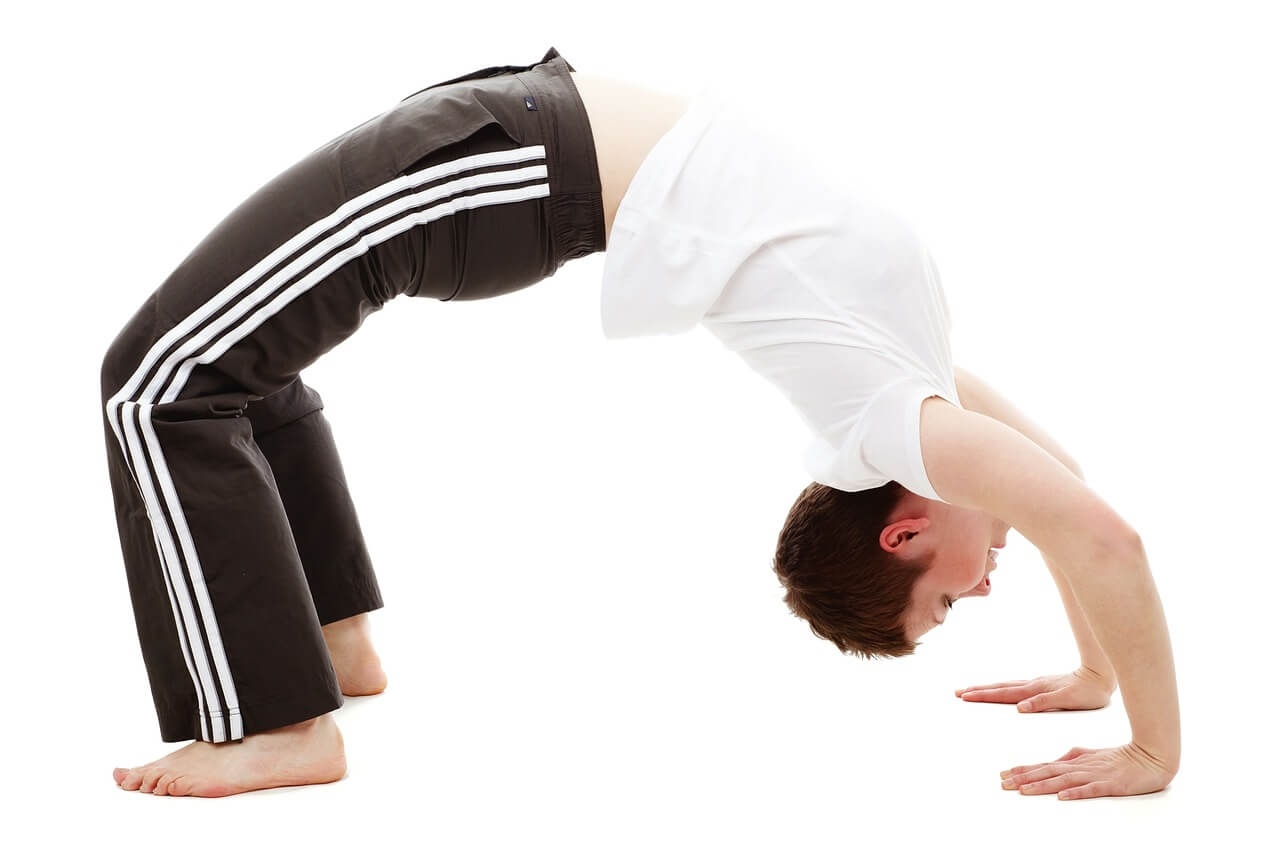
How to do a bridge: While lying on their back, gymnasts should place their hands next to their ears with their palms touching the mat. Elbows and knees should be bent and pointed to the ceiling. When the gymnast is ready they should lift their hips up, pushing down on the mat with their hands and feet. They should first be able to achieve an inverted ‘C’ position before graduating into a bridge with straight legs and arms.
11) Tripod
Achieving a balanced tripod is the first step in learning to do a headstand. It can also be combined with a front roll (ie: tripod to front roll-out) to teach gymnasts how to safely exit out of inverted positions when going off-balance.
How to do a tripod: Similar to a front roll, gymnasts should bend their knees and place their hands on the mat in a crouched position. The key to a tripod is making a triangle with three points of contact between the gymnast and the mat. The first two points are the hands (forming the base of the triangle) and the third point of contact is the head (the top point of the triangle). Leaning forward from the couched position with their hands on the mat, the gymnast should place the top of their head to the mat and bring their knees to rest on their elbows. The gymnast should be able to balance in this inverted position for at least 3 seconds.
Beginner Gymnastics Moves Build A Strong Foundation for Sport
As we’ve previously mentioned in our benefits of gymnastics article, gymnastics produces the most athletic athletes of any sport. Practicing gymnastics increases a child’s strength, flexibility, coordination and body awareness. These benefits help children build a strong foundation for any sport they’d like to pursue.
The above beginner gymnastics moves aren’t flashy but they will be repeated throughout an athlete’s life. So, by learning how to complete these movements safely, you can help put your child on a path to enjoy a variety of sports and activities!
Can you think of any beginner gymnastics skills we missed? Feel free to reach out and let us know on Facebook, Twitter or Instagram!

